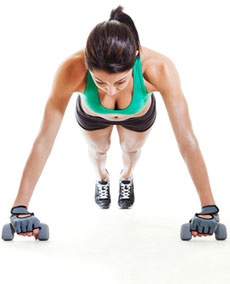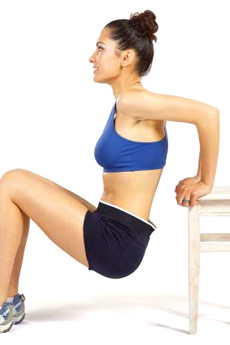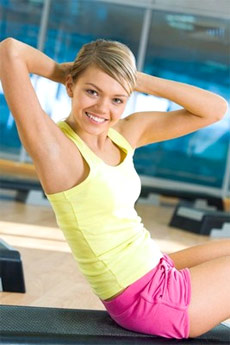Body Weight Training: A Top Fitness Option for 2013
 According
to a survey submitted by The American College of Sports Medicine (ACSM), Body weight
training is at number three
position in Top Fitness Trend for 2013. Body weight training has become
increasing popular with “at home” exercisers and folks “on the road.” Also
because, it's affordable (no equipment to purchase), speeds up the workout time
(no equipment to adjust), and doesn’t require much space. According
to a survey submitted by The American College of Sports Medicine (ACSM), Body weight
training is at number three
position in Top Fitness Trend for 2013. Body weight training has become
increasing popular with “at home” exercisers and folks “on the road.” Also
because, it's affordable (no equipment to purchase), speeds up the workout time
(no equipment to adjust), and doesn’t require much space.
As the name implies, it involves using your body's own weight as the source of
resistance to build up strength and endurance. WF has compiled the body weight
training alternate exercises,
for a complete body workout.
-
Push-Up: A basic push up does not require any equipment other than
your own body weight and your arms. It
can be done anywhere there is a firm surface. And it works the chest,
the shoulders, abs,
and the triceps.
Modifications can be made for different fitness levels. If a traditional
push-up is too hard, try resting your knees on the ground while you push-up.
To do the exercise: Assume a prone position on the floor or other hard
surface that's able to support your body weight. Keep your feet together.
Place your hands under your shoulders with your palms on the ground. Curl
your toes upward (towards your head) so that the balls of your feet touch
the ground. Raise yourself using your arms. At this point, your weight
should be supported by your hands and the balls of your feet. This is the
beginning and the end position of a single push-up. Lower your torso to the
ground until your elbows form a 90 degree angle. Keep your head facing
forward. Try to have the tip of your nose pointed directly to the front as
you're going down. Draw a breath as you lower yourself. Raise yourself by
attempting to push the ground away from you. Breathe out as you push. The
power for that push will inevitably come from your shoulders and chest.
Continue the push until your arms are just about straight. Stretch the
chest and shoulder muscles during your cool down cycle.
-
Plank: A great way to work your abdominals as well as your entire
core. By forcing your body to stabilize itself in one position, planks work
both your abdominal
muscles as well as your back
muscles. Get in a pushup position but instead of resting on your hands,
you rest on your forearms. You hold your back completely straight while
trying to hold your abdominals in. While it may sound easy, the longer you
try to perform a plank, the harder it will be. You might start with 30
second sets and work your way up to 2-3 minutes. Repeat for 3-5 reps. For
the obliques,
try lifting your right leg and bending at the knee, twist slightly at the
trunk and reach your knee towards your hip. Return to plank pose position
and repeat up to 25 times, once done repeat with your other leg. Repeat this
move on both sides for 15 to 25 repetitions. Engage your abs not your lower
back. You can even perform this exercise while standing.
-
 Dips: For
this you need two support, possibly chair(s) or any stable surface. Position
yourself between the chairs, supporting your weight on your hands and with your
feet out in front of you. Looking ahead, slowly lower yourself until your upper
arms are parallel to the seat of the chairs. Hold in lower position before
pushing back up until your arms are fully extended again. Repeat for the desired
number of repetitions. The intensity of this exercise can be adjusted by using
steps or chairs of different heights. Dips: For
this you need two support, possibly chair(s) or any stable surface. Position
yourself between the chairs, supporting your weight on your hands and with your
feet out in front of you. Looking ahead, slowly lower yourself until your upper
arms are parallel to the seat of the chairs. Hold in lower position before
pushing back up until your arms are fully extended again. Repeat for the desired
number of repetitions. The intensity of this exercise can be adjusted by using
steps or chairs of different heights.
-
Pull-Ups: Also known as chin-ups. Pull-ups are the ultimate test of
strength to weight ratio. Having a high strength to weight ratio means lots
of things like; being able to rock climb better, being able to sprint
faster, being able to run up hills faster, being able to pull water to make
your kayak go faster, etc. Secondly, no exercise will develop your back like
pull-ups. And finally, your upper arms, shoulders, forearms, abs, and grip
strength will all be attended to. You will need a bar to perform this move.
To conduct the exercise: Grab the pull-up bar with your hands placed about
shoulder width apart and your palms facing away from you. Pull yourself
upward until your chin is over the bar and complete the exercise by slowly
moving to the hanging position
-
Squats: Squats are
one of the best lower body exercises you can do. They are multi-joint exercises
which target all the muscles of the hips, glutes and thighs. Fast paced frequent
repetitions will produce maximum results. For beginners to do the exercise:
Place a chair just behind you and stand in front of it with feet about hip-or
shoulder-width apart. Contract the abs and keep them tight as you bend the knees
and slowly squat towards the chair. Keep the knees behind the toes as you sit
down on the chair for a few seconds. Contract the glutes and hamstrings to lift
up out of the chair and begin extending the legs. Fully extend the legs until
you're back to standing position. Repeat this for 1-3 sets of 10-16 repetitions.
To progress, squat down until you're just hovering over the chair, but not
sitting all the way down. Always keep the knees in line with the toes!
-
Lunges: Lunges are great for working all the major muscles of the hips,
glutes and thighs.
For beginners, you can try this move while holding onto a chair or wall for
balance. Stand with right foot forward, left foot back about 3 feet apart.
Hold weights in each hand if desired and bend the knees to lower the body
towards the floor. Keep the front knee behind the toes and be sure to lower
straight down rather than forward. Keep the torso straight and abs in as you
push through the front heel and back to starting position. Don't lock the
knees at the top of the movement. Perform 1-3 sets of 8-16 reps according to
your fitness level and goals. Walking lunges as well as side lunges, are a
great way to tone legs without using a machine.
-
 Sit-Ups: Lifting
your body from the core will shape mid-section muscles. There are many
popular modifications to this exercise like crunches and
side sit-ups. To do a sit-up: Lie down on the floor. Have your knees bent
and the balls of your feet and heels placed flat on the ground. Place your
hands behind the lobes of your ears, or even hold your ears. Avoid grabbing
the back of your head or neck, as this may cause injury down the road if you
pull too hard or in the wrong direction. You can also cross your arms across
your chest and touch your shoulders. Tighten your abdominal muscles by
drawing in your belly button to your spine. Keeping your heels on the ground
and your toes flat to the ground, slowly lift your head first, followed by
your shoulder blades. Focus your eyes on your bent knees, all the while
contracting the abdominal muscles. Pull up from the floor about half way.
Hold the position for a second. Slowly bring the torso back to the floor but
try to keep it slightly elevated off the ground. This means not to place
your back flat to the ground but to keep a slight, yet relaxed, arch. Only
do two to three sets if you are a beginner and slowly build up the amount
over time, as your strength increases. Sit-Ups: Lifting
your body from the core will shape mid-section muscles. There are many
popular modifications to this exercise like crunches and
side sit-ups. To do a sit-up: Lie down on the floor. Have your knees bent
and the balls of your feet and heels placed flat on the ground. Place your
hands behind the lobes of your ears, or even hold your ears. Avoid grabbing
the back of your head or neck, as this may cause injury down the road if you
pull too hard or in the wrong direction. You can also cross your arms across
your chest and touch your shoulders. Tighten your abdominal muscles by
drawing in your belly button to your spine. Keeping your heels on the ground
and your toes flat to the ground, slowly lift your head first, followed by
your shoulder blades. Focus your eyes on your bent knees, all the while
contracting the abdominal muscles. Pull up from the floor about half way.
Hold the position for a second. Slowly bring the torso back to the floor but
try to keep it slightly elevated off the ground. This means not to place
your back flat to the ground but to keep a slight, yet relaxed, arch. Only
do two to three sets if you are a beginner and slowly build up the amount
over time, as your strength increases.
-
Leg Lifts/Raises: Extend one leg so that it is parallel with the
other knee. Flex the raised foot, then bounce the raised leg up and down.
The smaller the movement, the more effective it will be. Aim for about
twenty small bounces, then slowly squeeze the leg back to its original
position and swap legs. To target the inner and outer thigh muscles, repeat
the exercise but move your leg out to the side and back instead of up and
down. For the inner thigh muscles specifically, turn your foot out to the
side when you flex it; your ankle should be pointing towards the ceiling.
Remember, to gain muscle and
strength you need significant loading and tension. Always go slow, even when
you're fatigued. Quality is better than quantity in any workout
program.
Your body weight can serve the
purpose well.
Dated 20 December 2012
Related Links
|









